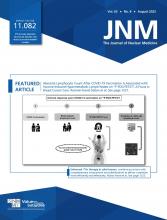TO THE EDITOR: Accurate antemortem diagnosis of neurodegenerative dementia is vital for appropriate counseling and enrollment of patients in disease-modifying clinical trials. Although the advent of biomarker imaging such as amyloid and tau PET has drastically improved our antemortem ability to diagnose Alzheimer disease (AD) pathology, the recognition of specific patterns of glucose metabolism on 18F-FDG PET is crucial for the diagnosis of degenerative conditions without disease-specific neuroimaging biomarkers, such as dementia with Lewy bodies or limbic-predominant age-related TAR DNA binding protein 43 (TDP-43) encephalopathy (LATE). Because of the significant clinical overlap between LATE and typical AD, 18F-FDG PET serves as a valuable diagnostic tool for the workup of amnestic dementia (1).
In a recent issue of The Journal of Nuclear Medicine (2), Rieger and Silverman aimed to highlight 18F-FDG PET neuroimaging findings differentiating LATE from other neurodegenerative dementias with a case example. They reported a patient with multidomain amnestic cognitive dysfunction with 18F-FDG PET imaging showing moderately severe anterior temporal and parietotemporal hypometabolism with preservation of the posterior cingulate cortex (PCC) and occipital cortex. They argued that sparing of the PCC in their patient would be inconsistent with AD whereas the absence of occipital hypometabolism would argue against dementia with Lewy bodies, both of which may support LATE as an etiology for the patient’s amnestic cognitive impairment. Although sparing of the PCC compared with the precuneus or cuneus (cingulate island sign) and involvement of the occipital lobe is indeed the classic pattern for dementia with Lewy bodies, we disagree that sparing of the PCC in this case is supportive of LATE and inconsistent with AD (3).
Recent data suggest that medial temporal, posterior cingulate, and frontal supraorbital hypometabolism are predictors of LATE whereas prominent inferior temporal involvement may be predictive of AD (4). Antemortem studies of amnestic dementia patients have demonstrated medial temporal and PCC hypometabolism to be more prominent in amyloid-negative (5) and tau-negative patients (6), whereas tau-positive (i.e., AD) patients showed more lateral and inferior temporal involvement, as well as parietal involvement. This pattern was corroborated by autopsy data showing patients with LATE and hippocampal sclerosis who had prominent medial temporal and PCC hypometabolism (6). On the basis of these data, an elevated ratio of inferior-to-medial temporal lobe metabolism was proposed as an 18F-FDG PET marker of LATE, as the authors correctly pointed out. This pattern was subsequently confirmed by an independent group of investigators in the Alzheimer’s Disease Neuroimaging Initiative (7).
The relevance of PCC involvement or sparing in predicting the underlying pathology is more nuanced. Although not all studies have supported PCC hypometabolism as predictive of LATE (4), some autopsy-confirmed cases of LATE had marked, focal hypometabolism of the PCC (inverse cingulate island sign) (6). We provide 3 examples of amyloid- and tau-negative amnestic dementia cases with clear PCC involvement in Figure 1. Molecular pathology data have shown lower mitochondrial DNA copy numbers in the PCC—a finding that was explained by the presence of TDP-43 pathology but not tau, further supporting the link between LATE and PCC hypometabolism (8). PCC hypometabolism has also been tied to hippocampal atrophy in cognitively normal individuals and those with MCI, whereas it was attributed to local atrophy in AD dementia (9). PCC hypometabolism likely reflects the presence of limbic, and more specifically medial temporal, neurodegeneration, which would explain why the PCC is involved in LATE and typical AD but is relatively spared in dementia with Lewy bodies and some hippocampal-sparing AD phenotypes (10). As such, the preservation of PCC metabolism in the absence of medial temporal hypometabolism in the authors’ case is entirely expected and should not be taken as evidence for LATE or against some forms of AD, especially in light of the inferior temporal and parietal hypometabolism.
Amyloid- and tau-negative amnestic dementia patients with PCC involvement. Shown are 3-dimensional stereotactic surface projection z score images generated with CortexID (GE Healthcare) indicating hypometabolism in patients compared with age- and sex-matched controls. All 3 patients were from our recent paper on 18F-FDG PET in tau-negative amnestic dementia (6). All 3 patients had PCC hypometabolism (top row, arrows), as well as prominent medial temporal hypometabolism (bottom row, arrows). Third patient (right column) has since come to autopsy and had low-stage Alzheimer disease (A1B1C1) according to criteria of National Institute on Aging–Alzheimer’s Association, as well as hippocampal sclerosis with TDP-43 (LATE). A = amyloid; T = tau.
Although we await TDP-43–specific tracers for an antemortem diagnosis of LATE, 18F-FDG PET in conjunction with structural brain imaging remains our most useful neuroimaging tool in individuals presenting with amnestic cognitive impairment. Clinicians and radiologists should pay specific attention to the medial temporal lobe and PCC in older patients with amnestic dementia. Specifically, greater medial than inferior temporal lobe hypometabolism is highly suggestive of the presence of LATE. Finally, PCC metabolism may be affected by multiple processes, highlighting the importance of integrating the clinical phenotype with all available neuroimaging data to obtain the most accurate diagnosis.
DISCLOSURE
This work is supported by National Institutes of Health (NIH) grants P50 AG016574, U01 AG006786, R37 AG11378, R01 AG054449, R01 AG041851, R01 AG011378, R01 AG034676, R01 AG37491, and R01 NS097495; the Robert Wood Johnson Foundation; the Elsie and Marvin Dekelboum Family Foundation; the Liston Family Foundation; the Robert H. and Clarice Smith and Abigail van Buren Alzheimer Disease Research Program; the Gerald and Henrietta Rauenhorst Foundation; Foundation Dr. Corinne Schuler (Geneva, Switzerland); the Alexander Family Alzheimer Disease Research Professorship of the Mayo Clinic, and the Mayo Foundation for Medical Education and Research. No other potential conflict of interest relevant to this article was reported.
Footnotes
Published online Mar. 24, 2022.
- © 2022 by the Society of Nuclear Medicine and Molecular Imaging.
REFERENCES
- Received for publication March 9, 2022.
- Accepted for publication March 21, 2022.








